Tools add capabilities to your AI agent. User can enable tools to allow agent to take actions during conversations.
Tools enable agent to:
- Take actions (end calls, transfer calls, send emails)
- Access external systems (calendars, CRMs, webhooks)
- Retrieve information from knowledge bases
- Execute workflows
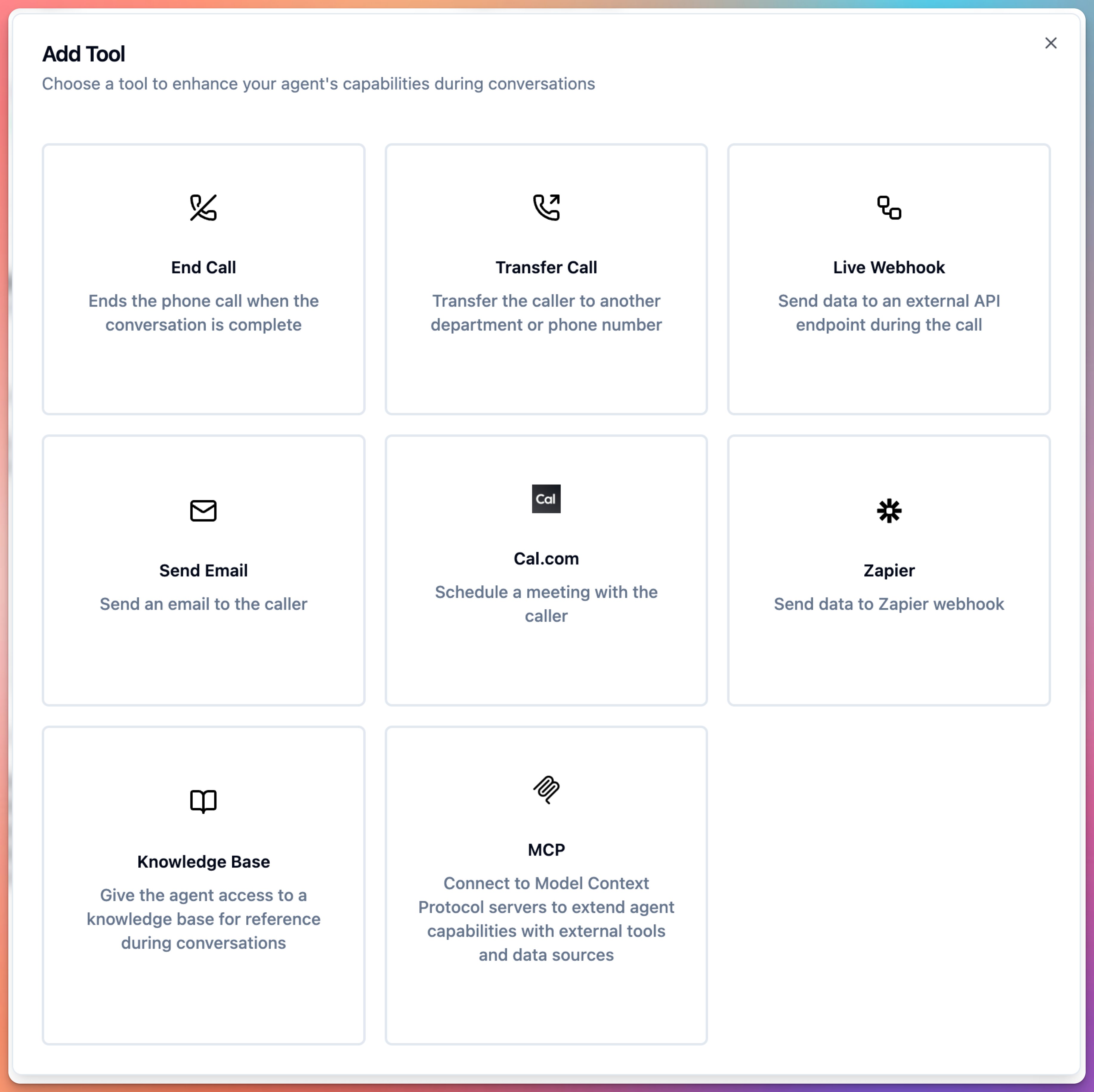 User can choose from:
User can choose from:
- End Call: Ends phone call when conversation complete
- Transfer Call: Transfer to another department or phone number
- Live Webhook: Send data to external API endpoint during call
- Send Email: Send email to the caller
- Cal.com: Schedule meeting with caller
- Zapier: Send data to Zapier webhook
- Knowledge Base: Access knowledge base for reference
- MCP: Connect to Model Context Protocol servers
User can add tools:
- Go to AI Instructions screen
- Scroll to Tools section (bottom)
- Click + button (top right)
- Select tool type from list
- Fill configuration fields
- Click “Add Tool”
At least one tool must be enabled. end_call tool is enabled by default.
End Call
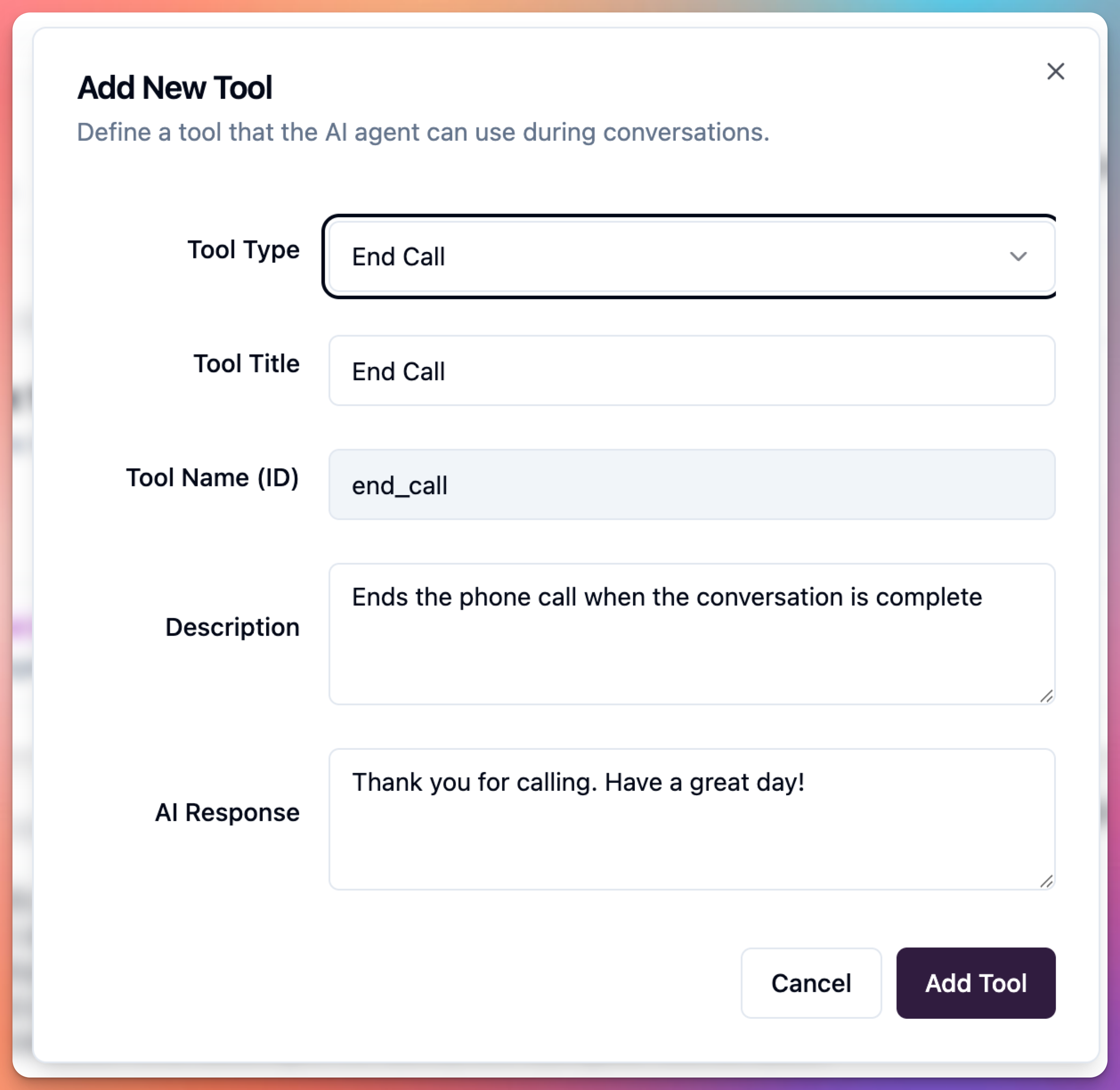 User can configure end_call tool with:
Fields:
User can configure end_call tool with:
Fields:
- Tool Type: End Call
- Tool Title: End Call
- Tool Name (ID):
end_call
- Description: “Ends the phone call when the conversation is complete”
- AI Response: “Thank you for calling. Have a great day!”
Prompting:
Use end_call when:
- User says "goodbye," "bye," "that's all"
- User confirms no more help needed
- All tasks completed
Before ending: Ask "Is there anything else I can help you with?"
Transfer Call
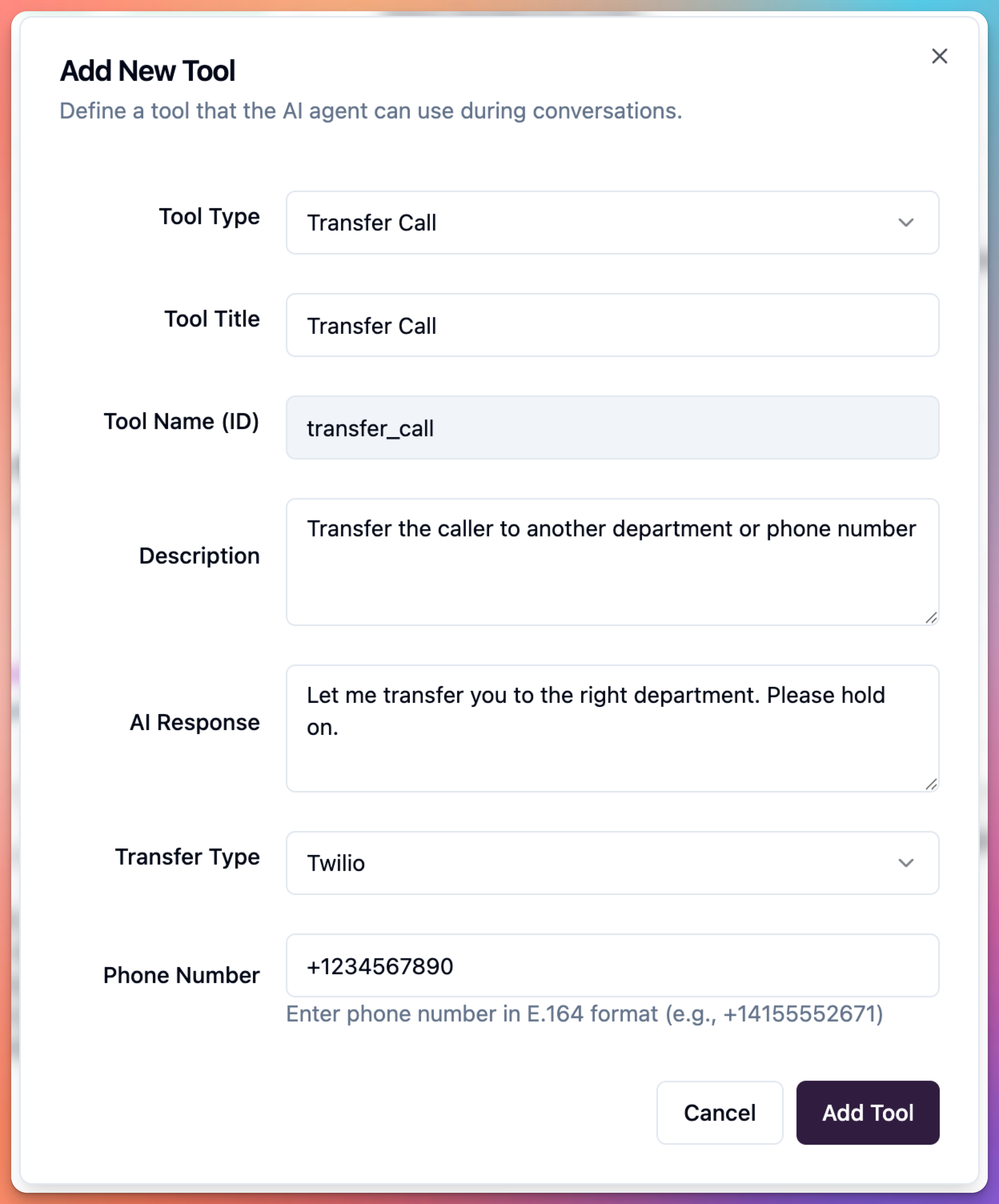 User can configure transfer_call tool with:
Fields:
User can configure transfer_call tool with:
Fields:
- Tool Type: Transfer Call
- Tool Title: Transfer Call
- Tool Name (ID):
transfer_call
- Description: “Transfer the caller to another department or phone number”
- AI Response: “Let me transfer you to the right department. Please hold on.”
- Transfer Type: Twilio, SIP Trunk, or Ziwo (dropdown)
- Phone Number: E.164 format (e.g., +14155552671)
SIP Trunk Configuration Requirements:When using Transfer Type = SIP Trunk:Destination Format:
- Destination MUST be a SIP URI (not a phone number)
- Format:
sip:extension@domain.com or sip:number@ip.address
- Example:
sip:support@company.com or sip:100@192.168.1.10
Target System Requirements:
- Target SIP server MUST accept SIP REFER method
- Target system MUST whitelist Callab AI SIP IP:
104.197.91.206:5060
Configuration Steps:
- Configure your SIP server to accept SIP REFER
- Add Callab AI IP to whitelist:
104.197.91.206:5060
- Use SIP URI format for destination (not E.164)
- Test transfer before production use
Without proper SIP REFER support and IP whitelisting, transfers will fail. Use transfer_call when:
- User asks to speak with human agent
- User says "I want to talk to a real person"
- Situation too complex
- User frustrated or dissatisfied
- Missing information to help
Never mention "function" or "tool"
Before transferring: Explain why you're transferring
Live Webhook
 User can configure send_webhook tool with:
Fields:
User can configure send_webhook tool with:
Fields:
- Tool Name (ID):
send_webhook
- Description: “Send data to an external API endpoint during the call”
- AI Response: “Let me process that information for you.”
- Method: POST, GET, PUT, DELETE (dropdown)
- URL:
https://api.example.com/webhook
- Headers: JSON format (e.g.,
Content-Type, Authorization)
- Body: JSON with variables like
timestamp, caller_number, call_duration
Prompting:
Use send_webhook when:
- Fetch customer information
- Check order status
- Verify account details
- Send data to external systems
Always inform user: "Let me look that up..."
If fails: "I'm having trouble. Let me transfer you."
Zapier Webhook
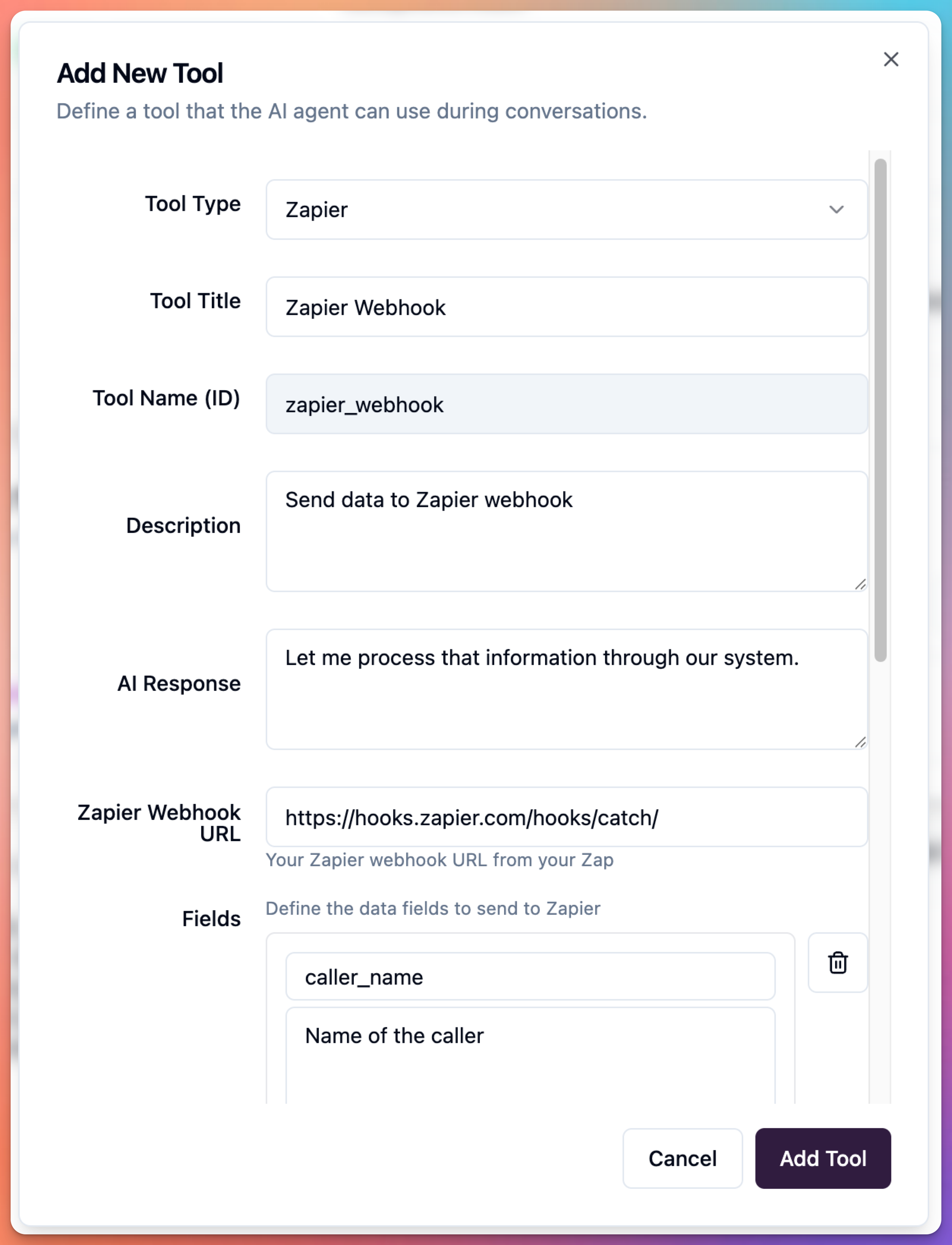 User can configure zapier_webhook tool with:
Fields:
User can configure zapier_webhook tool with:
Fields:
- Tool Type: Zapier
- Tool Title: Zapier Webhook
- Tool Name (ID):
zapier_webhook
- Description: “Send data to Zapier webhook”
- AI Response: “Let me process that information through our system.”
- Zapier Webhook URL: https://hooks.zapier.com/hooks/catch/
- Fields: Define data fields to send (field name + description)
Prompting:
Use zapier_webhook to:
- Add contact to CRM
- Send follow-up email
- Create task in project tool
- Log call details
Trigger silently in background when appropriate
Confirm outcome: "I've got that recorded"
Send Email
 User can configure send_email tool with:
Fields:
User can configure send_email tool with:
Fields:
- Tool Type: Send Email
- Tool Title: Send Email
- Tool Name (ID):
send_email
- Description: “Send an email to the caller”
- AI Response: “Let me send you an email with the information you requested.”
- Email Subject: Subject line
- Email Content: Template with variables like
caller_name
Prompting:
Use send_email when:
- User requests "email me" or "send me that"
- Send confirmation or documentation
- Follow-up after call
Always confirm email: "I'll send to [email]. Is that correct?"
Tell them what to expect: "You'll receive [content description]"
Knowledge Base
User can configure knowledge_base tool (no screenshot - built-in feature):
Prompting:
Use knowledge_base when:
- User asks about products, services, policies
- Need specific technical information
- User asks "how do I..." or "what is..."
Query with keywords from user's question
Present conversationally, not as direct quote
If not found: "Let me connect you with someone who knows"
Calendar Booking
 User can configure Cal.com tool with:
Fields:
User can configure Cal.com tool with:
Fields:
- Tool Type: Cal.com
- Tool Title: Schedule Meeting
- Tool Name (ID):
schedule_meeting
- Description: “Schedule a meeting with the caller using Cal.com”
- AI Response: “Let me schedule a meeting for you.”
- Cal.com API Key: (required)
- Event Type ID: (required)
Prompting:
Use schedule_meeting when:
- User wants to schedule appointment
- User asks "when are you available" or "can I book"
Flow:
1. Check available slots
2. Present 2-3 options: "I have Tuesday 2PM or Wednesday 10AM"
3. User chooses
4. Confirm: "You're scheduled for [day] at [time]"
5. Ask about confirmation email
Collect before booking: name, email, phone
MCP (Model Context Protocol)
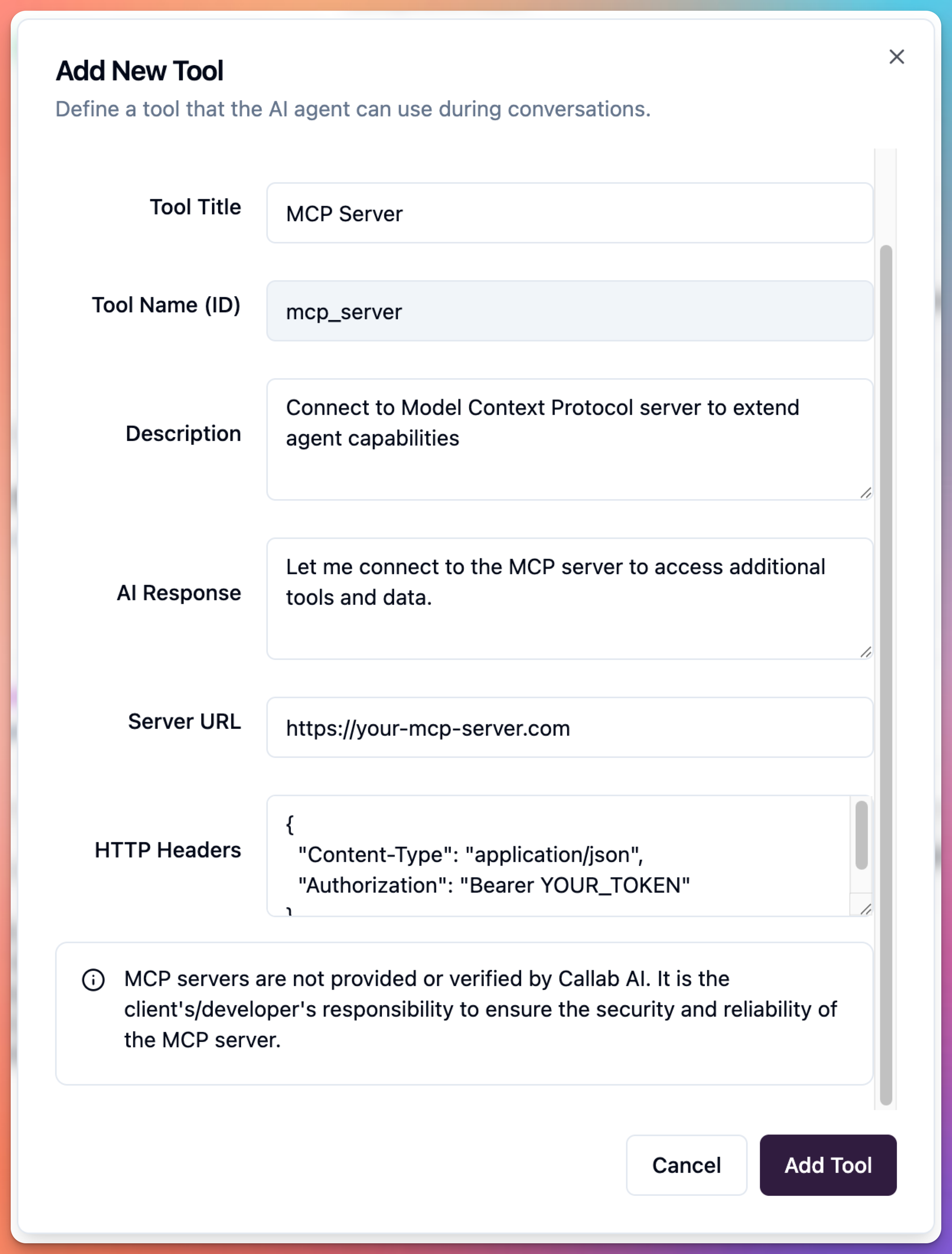 User can configure MCP tool with:
Fields:
User can configure MCP tool with:
Fields:
- Tool Title: MCP Server
- Tool Name (ID):
mcp_server
- Description: “Connect to Model Context Protocol server to extend agent capabilities”
- AI Response: “Let me connect to the MCP server to access additional tools and data.”
- Server URL: https://your-mcp-server.com
- HTTP Headers: JSON format (Content-Type, Authorization)
MCP servers are not provided or verified by Callab AI. It is the client’s/developer’s responsibility to ensure the security and reliability of the MCP server.
Use mcp_server when:
- Need to access external tools or data sources
- Extend agent capabilities beyond built-in tools
- Connect to custom integrations
Agent response should be transparent about accessing external systems
## Tool Guidelines
When to use:
- Only when explicitly needed
- Never mention "function," "tool," or technical terms
- Use silently and naturally
Tool flow:
1. Acknowledge request
2. Trigger tool
3. Provide result conversationally
4. Confirm action completed
Error handling:
- Don't mention technical errors
- Apologize: "I'm having trouble with that"
- Offer alternative: transfer or collect info for follow-up
Multiple tools:
- Can use in sequence
- Example: knowledge_base → send_email → end_call
Tool priority:
1. Most direct solution
2. Ask clarifying questions if unsure
3. Default to safest (transfer if uncertain)
Advanced Patterns
Conditional Logic
User can use conditional tool logic:
If satisfied and complete → end_call
If frustrated → transfer_call
If product question → knowledge_base (if found: share, if not: transfer)
If schedule → calendar_booking + send_email
Appointment Booking:
1. calendar_booking (check availability)
2. Present options
3. User selects
4. calendar_booking (confirm)
5. send_email (confirmation)
6. end_call
Silent Execution
User can execute tools silently:
Zapier webhooks: Execute after collecting info, confirm outcome
Live webhooks: Log automatically in background
Testing
User must test:
- Happy path (everything works)
- Error scenarios (tools fail)
- Edge cases (unusual requests)
- Tool combinations (multiple workflows)
- User variations (“goodbye” vs “bye” vs “that’s all”)
Common Mistakes
User must avoid:
- Mentioning “function,” “tool,” or “API” to callers
- Using tools unnecessarily
- Not handling errors gracefully
- Assuming tools always work
- Over-explaining background operations
User must do:
- Keep tool usage natural
- Confirm actions with callers
- Have fallback plans
- Test before production
- Update based on real usage
Examples
Customer Support
end_call: Use when user says goodbye
transfer_call: Use when needs human (to +1-555-SUPPORT)
knowledge_base: Use for product questions
Appointment Booking
calendar_booking: Check availability → Present options → Confirm
send_email: Send confirmation with date, time, location
end_call: After booking complete
Next Steps
User can:
- Test each tool individually
- Test tool combinations
- Monitor real conversations
- Refine prompts based on usage
- Update configurations as needed
Start with end_call and transfer_call, then add advanced tools gradually.
 User can choose from:
User can choose from:
 User can configure end_call tool with:
Fields:
User can configure end_call tool with:
Fields:
 User can configure transfer_call tool with:
Fields:
User can configure transfer_call tool with:
Fields:
 User can configure send_webhook tool with:
Fields:
User can configure send_webhook tool with:
Fields:
 User can configure zapier_webhook tool with:
Fields:
User can configure zapier_webhook tool with:
Fields:
 User can configure send_email tool with:
Fields:
User can configure send_email tool with:
Fields:
 User can configure Cal.com tool with:
Fields:
User can configure Cal.com tool with:
Fields:
 User can configure MCP tool with:
Fields:
User can configure MCP tool with:
Fields:

